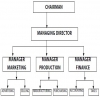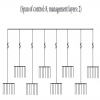Home | ARTS | Management Concepts & Organisational Behaviour
|
Factors Influencing Span of Management - Organisation Structure And Design
Management Concepts & Organisational Behaviour - Organisation Structure And Design
Factors Influencing Span of Management - Organisation Structure And Design
Posted On :
Factors Influencing Span of Management - Organisation Structure And Design
Factors Influencing Span of
Management
Manager’s personality: If managers share a strong need for power, they may prefer a wider span of control. On the other hand, some managers feel threatened because they cannot oversee the activities of too many people. Such managers would naturally prefer a narrow span.
Manager’s capability: An experienced, well trained and knowledgeable manger is normally
able to handle a relatively wider span than a less capable manager.
Subordinates capabilities: Experienced and well-trained subordinates will be able to
resolve the difficulties themselves. They do not take much of the time of the
superior. The need for frequent contacts is also obviously less.
Fatigue tolerance: Physical and mental fatigue may limit a manager’s capacity for control.
There are only so many hours in a day, and only so many things can be done at a
time. Consequently, the greater the physical or mental demands of a job, the
narrower the span of control.
Activity level: The pace and pattern or work in an engineering firm, an investment firm, and a university differ in many respects. Moreover, there also exist differences between the various units of an organization. For example, production activity compared to public relations. Thus, the more active the pace and pattern of a manager’s work, the narrower the appropriate span of control.
Non-supervisory activities: If a manager spends more time on non-supervisory activities like
long-range planning and outside assignments, he tends to have less time to
supervise the subordinates. This obviously limits the span.
Similarity of activities
supervised: If the nature of activities performed
by the subordinates is routine, the superior can manage many subordinates. On
the other hand, if unique and non-routine problems are more frequent, the span
is limited.
Complexity of work: Simple job assignments are
usually easier to supervise than complex ones. The problems that arise are
generally less demanding and take less of the superior’s time. Thus, less
supervision will be necessary, contributing for a wider span.
Availability of sophisticated facilities: Availability of more advanced and sophisticated facilities like high speed telecommunication devices, modern office equipment, etc., will help the manager in managing a relatively wider span.
Location: If subordinates are physically dispersed, a manager will need
to spend more time in travelling and communicating. The span of control in such
a case will be narrow. To conclude, it has to be remembered that despite the
desirability of flat structures, the span of management may be limited by
certain factors. As an enterprise grows, the increase in organization levels
cannot be completely avoided. What is required is a precise balancing of all
the factors in a given situation. Widening spans and reducing levels may be the
answer in some cases, while the opposite may be true in others.
Manager’s personality: If managers share a strong need for power, they may prefer a wider span of control. On the other hand, some managers feel threatened because they cannot oversee the activities of too many people. Such managers would naturally prefer a narrow span.
Activity level: The pace and pattern or work in an engineering firm, an investment firm, and a university differ in many respects. Moreover, there also exist differences between the various units of an organization. For example, production activity compared to public relations. Thus, the more active the pace and pattern of a manager’s work, the narrower the appropriate span of control.
supervision will be necessary, contributing for a wider span.
Availability of sophisticated facilities: Availability of more advanced and sophisticated facilities like high speed telecommunication devices, modern office equipment, etc., will help the manager in managing a relatively wider span.
Tags : Management Concepts & Organisational Behaviour - Organisation Structure And Design
Last 30 days 2676 views
















